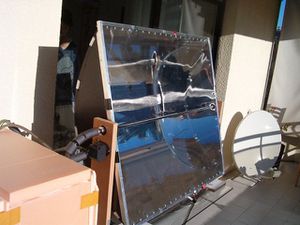Parabolic Trough Prototype
Introduction
Gang Xiao, professor at University of Nice, France, has developed a low-cost parabolic trough solar thermal concentrator, applicable to electricity production. He is pursuing the steam engine as the heat engine of choice.
Factor e Farm is interested in evaluating the performance of this system by building a prototype. Here are the detailed instructions for prototype deployment.
This method http://www.ffwdm.com/solar/solar-index.htm for constructing parabolic arrays deserves consideration as well. Demonstrated cost of $150 for 800 watt sections in Toronto Canada. Note that the pipe serves as the rotational bearing surface, eliminating need for flexible pipe connections. (Warning: this last one probably has a temperature limite too low for efficient power generation. The lifetime may also be a problem.)
Concept
Bill of Materials
Estimation of the material cost for 1m2 of collector. The costs are in dollars.
| Use | Material | Specification | Quantity | Cost |
|---|---|---|---|---|
| Cover | tempered glass | 5mm | 1.05m2 | ? |
| Back and ends | steel sheet | 0.5mm | 1.6m2 | ? |
| Mirror | adhesive mirror film | - | 1.6m2 | 12 |
| Structural pieces | stainless steel bars and angles | width around 15mm | ~15m | ? |
| Bearings | metal tubes | φ40mm×20mm | 2 | 2 |
| Support | Plastic pieces | to be moulded | 2 | 2? |
| Photodetector | photoresistors+case | - | 1 | 2? |
| Controller + gear | commercially available | - | 1 | 10-30 |
| Receiver | metal tube | configurable | ~1.2m | ~5 |
| Chassis | square steel tubes | 30mm | ~3m | 5? |
Questions:
Structural pieces - what is the thickness, and how much of it is angle and how much of it is bar?
--- Roughly, half-half. About 1mm thick.
Can the support pieces be printed with RepRap if we have access to it?
--- Yes.
Can you show a picture and dimensions of the plastic pieces?
--That will come.
Specify photodetector and photoresistor, plus size of case
--- See my DIY document.
- Where?--Dennis 09:04, 15 March 2009 (UTC)
- Sorry: I didn't know how to insert links. manual making of parabolic trough Azuredu 10:33, 15 March 2009 (UTC)
One axis controller, and what about the control motor?
Show the angle tilt mechanism.
Diameter and wall thickness of collector tube?
--- These are interchangeable.
What about sealing of corners?
-- Don't seal. The design takes care that direct rain water won't get in. For cleaning water jets, some kind of protection with sponge foam will be enough. Azuredu 19:56, 13 March 2009 (UTC)
What about reflective coating?
--- Mylar film.
- Any evidence or other examples of mylar being used for parabolics for solar concentrators?--Dennis 15:12, 12 March 2009 (UTC)
- The best example is car headlights. This is not exactly mylar, but the technology is the same: a metal reflective coating protected by a plastic sheet cover. Otherwise, [Absolicon.com Absolicon.com] is selling troughs using silver-coted mylar mirrors, but the commercialization is still very limited. Here the point is that mylar must be protected from humidity, rain water and dust (or more exactly cleaning scratch).Azuredu 19:51, 13 March 2009 (UTC)
What about couplers for collector tube and inter-collector connection for stringing multiple collectors?
--- Ordinary (home water supply) tube connectors.
What about stand and base?
--- Rather free design.
